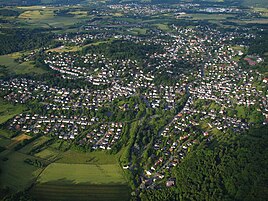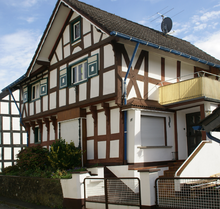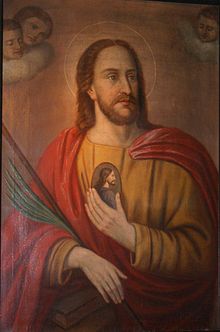Heisterbacherrott
|
Heisterbacherrott
City of Koenigswinter
|
||
|---|---|---|
| Coordinates: 50 ° 41 ′ 48 ″ N , 7 ° 14 ′ 10 ″ E | ||
| Height : | 181 (168-235) m above sea level NHN | |
| Area : | 2 km² | |
| Residents : | 1970 (Dec. 31, 2019) | |
| Population density : | 985 inhabitants / km² | |
| Incorporation : | 1st August 1969 | |
| Postal code : | 53639 | |
| Area code : | 02244 | |
|
Location of Heisterbacherrott in North Rhine-Westphalia |
||
|
Heisterbacherrott seen from the southwest
|
||
Heisterbacherrott is a district of Königswinter in the Rhein-Sieg district of North Rhine-Westphalia with around 2000 inhabitants. It is located on the northern edge of the Siebengebirge and is a place of pilgrimage .
history
In a document from Archbishop Philipp von Heinsberg of Cologne , Heisterbacherrott is mentioned in 1173 as Rhoda .
From 1555 at the latest, Heisterbacherrott was an honor in the Bergisch office of Löwenburg . In the topographical survey of the Rhineland carried out at the beginning of the 19th century , the place name was Heisterbacheroth .
The former municipality of Heisterbacherrott belonged to the Oberkassel mayor . In 1885 the community had an area of 200 ha , of which 159 ha were arable, 6 ha were meadows and 28 ha were forest. Today the area belongs to the city of Königswinter . In 1885 the community consisted of Heisterbacherrott and two other districts: Frohnhof and Scheid . There were 88 residential buildings (including uninhabited) with 91 households in the parish. There lived 446 inhabitants (223 men and 223 women). All citizens were Catholic at the time, the parish had its parish church in Niederdollendorf .
The church in the center of the village is dedicated to St. Jude Thaddäus . The building, built in 1892 from quarry stones from the Stenzelberg , contains relics of the saint and a miraculous image with his depiction.
In 1967 Heisterbacherrott had 1,303 inhabitants, of which 24 worked in agriculture and forestry, 231 in manufacturing and 158 in the service sector. 12 employees worked in an industrial company. 323 out-commuters were compared to 16 in-commuters. In 1967 there were public facilities: a not fully developed elementary school, a sports field, a library.
Heisterbacherrott has been a district of Königswinter since August 1, 1969 .
Population development
| year | Residents |
|---|---|
| 1816 | 363 |
| 1828 | 246 |
| 1843 | 334 |
| 1885 | 446 |
| 1912 | 503 |
| 1939 | 624 |
| 1961 | 1012 |
| 2006 | 2241 |
| 2018 | 1992 |
Culture and sights
In Heisterbacherrott you will find the oldest half-timbered house in the city of Königswinter (Petrusstraße 11) in terms of dating to 1560 .
Heisterbach Monastery

The former Heisterbach monastery is located in the Heisterbach Valley between Oberdollendorf and Heisterbacherrott ( Königswinter urban area ).
House of Silesia
House of Silesia used to be a Cistercian farm yard . The farm on Hauptstrasse was founded in 1978 by the Haus Schlesien e. V. acquired and rebuilt by 1981. Today the former Fronhof houses, among other things, a culture and education center, a museum for Silesian regional studies and a reference library. In front of the main building, a bust created by Arno Breker in 1988 commemorates the Silesian poet Gerhart Hauptmann . A group of trees made up of five plane trees , which are up to 31 meters high and 190 years old at the top, has also been designated as a natural monument .
Nikolauskapelle
Today's Nikolauskapelle was built around 1150 as St. Mark's Chapel in Latit vom Stenzelberg and at that time it should have been part of the Roda-Hof. Later, St. Bernard was the patron saint of the chapel for some time . The chapel was badly damaged in the Thirty Years War and rebuilt in 1676, with the Romanesque cross vault being replaced by a wooden roof. It was then consecrated to St. Nicholas (Nikolaus von Myra is the patron saint of fishermen and traveling traders; the trade route from Kircheib to the fishing village of Niederdollendorf passed the chapel ). At first it was owned by the Schwarzrheindorf convent together with the Fronhof. In the 13th century it went to Heisterbach Abbey and stayed there until secularization in 1803. Afterwards it was administered by the Niederdollendorf parish and, after some repairs and subsequent inauguration, was owned by the Heisterbacherrott Rectorate Parish, which was established at the time . After the parish church of St. Judas Thaddäus was completed in 1892, there were no more services in the Nikolauskapelle, so that it was initially no longer repaired and left to decay. Around 1905, the new owner of the Fronhof began converting the chapel into a family crypt chapel , but this was not completed. It then served the Fronhof as a material store. In the course of a first renovation after this misuse in 1933, today's altar table was created.
The chapel suffered a lot during the Second World War when it was used as a storage room for artificial fertilizers. From 1973 to 1976, the masonry was renovated, including in 1973 stained glass windows with local motifs based on designs by the Leverkusen glass painter Paul Weigmann were installed inside , and in 1974 a road cross on the west side that was previously on the enclosure wall of House Silesia (built in 1663) were set up. The chapel was most recently endangered by rising damp. After preparatory work from 2000 on, a comprehensive restoration of the Nikolauskapelle began in December 2006 with financial support from the German Foundation for Monument Protection ; the interior renovation was completed by April 2008, the overall measure in the following year and sealed with the ceremonial consecration on September 20, 2009. In the niche let in above the entrance on the north side, there has been a statuette of St. Nicholas with a bishop's staff and miter by the local sculptor Sigrid Wenzel since 2009 , after the original niche figure is considered lost.
Judas Squidward pilgrimage
The veneration of the apostle Judas Thaddäus in Heisterbacherrott developed since the end of the 19th century. The place had its own pastor for the first time in 1866. A parish church was built in 1890–1892 and consecrated to St. Jude Thaddäus at the request of the founder Theodor Schiffers from Aachen. A picture of the parish patron, today's image of grace , came from the parish of Niederdollendorf in 1895/96 . It shows the saint as a half-length figure with a palm branch in his arm; in front of his chest he holds a medallion with the bust of Jesus. In 1911, Rector Jakob Schmidt acquired a relic of the saint.
Over time, believers began to kneel in front of the picture and seek solace in prayer. Gertrud Finette from Bad Godesberg made a pilgrimage to Heisterbacherrott for the first time in 1921 in gratitude for her recovery after double pneumonia and is considered to be the founder of the pilgrimage. More and more acquaintances joined her on her monthly pilgrimages. Rector Theodor Helten , parish rector from 1931, decisively promoted the pilgrimage. In 1932, in the second week of November, he founded a “Thaddäus Octave ”. Despite difficulties in the time of National Socialism with bans on Corpus Christi processions , the number of pilgrims rose steadily. In addition to Bad Godesberg, regular groups of pilgrims also came from Bonn , Siegburg and Brühl . The Bonn procession comprised 500 to 700, a maximum of 1400 participants; in the 1930s there were usually around 400 pilgrims from Godesberg.
After the Second World War , the pilgrimage continued to grow. Groups now came from all over the Rhineland . In 1977, 25,000 pilgrims were counted in the Festoktav - now at the end of October. In 1964, the Judas Thaddäus chapel attached to the parish church was consecrated, to which the miraculous image and the relic were transferred.
Leddeköpp monument
In front of the Nikolauskapelle is the "Leddeköpp monument" erected in autumn 2000 with a bronze plaque by the artist Sigrid Wenzel . It is intended to commemorate the hard work in the quarries (e.g. in neighboring Weilberg ) up to 1940. Their nickname "Leddeköpp", derived from the leather head and shoulder protection of the stone breakers of that time, is still attached to today's Heisterbach rotters.
Personalities
- Josef Scheuren (1898–1972), politician (SPD), born in Heisterbacherrott
- Hans-Christian Bues (* 1948), writer, lives in Heisterbacherrott
- Reiner Rübhausen (* 1960), social worker and cabaret artist, grew up in Heisterbacherrott
literature
- Karl Josef Klöhs: Imperial weather on the Siebengebirge. Edition Lodge 7, Königswinter 2003, ISBN 3-00-012113-7 .
- Karl Schumacher: The mills in the Heisterbacher Tal - How they rattled from the Middle Ages to the modern age --- Water management, historical development, mill technology, legends and poems, principle-site plan. Ed .: Heimatverein Oberdollendorf and Römlinghoven eV 2nd, reviewed edition, Königswinter 2011. 120 pages.
- Angelika Schyma : City of Königswinter. (= Monument topography Federal Republic of Germany , Monuments in the Rhineland , Volume 23.5.) Rheinland-Verlag, Cologne 1992, ISBN 3-7927-1200-8 , pp. 78–86.
Web links
- Heisterbacherrott
- The Heisterbacher Talbahn (1889–1950) with the "Weilberg model system"
- Postcards, photos and documents from Heisterbach
- The Virtual Museum Thomasberg - Heisterbacherrott
Individual evidence
- ↑ without secondary residences ; Population statistics of the city of Königswinter (PDF)
- ↑ Woldemar Harleß : The inquiry about the court system in the Duchy of Berg from 1555 , In: Journal of the Bergisches Geschichtsverein , Volume 20, year 1884, Bonn 1885, p. 123.
- ↑ a b Community encyclopedia for the Kingdom of Prussia from 1885
- ↑ http://www.kirche-am-oelberg.de/html/thomasberg.html
- ^ The Rhein-Sieg-Kreis . Publisher: Senior District Director Paul Kieras. Stuttgart 1983, p. 276.
- ↑ Martin Bünermann: The communities of the first reorganization program in North Rhine-Westphalia . Deutscher Gemeindeverlag, Cologne 1970, p. 84 .
- ↑ Alexander August Mützell, Leopold Krug (Ed.): New topographical-statistical-geographical dictionary of the Prussian state. Fifth volume. T-Z. With Karl August Kümmel, Halle 1823, p. 163 ( digitized version ).
- ^ Friedrich von Restorff: Topographical-statistical description of the Royal Prussian Rhine Province . Nicolaische Buchhandlung, Berlin / Stettin 1830, p. 295 ( digitized version ).
- ↑ Royal Government of Cologne (Ed.): Overview of the constituent parts and list of all the localities and individually named properties of the government district of Cologne, according to districts, mayorships and parishes, with information on the number of people and the residential buildings, as well as the Confessions, Jurisdictions , Military and earlier country conditions. Cologne 1845, p. 102 ( digitized version ).
- ↑ Martin Bünermann, Heinz Köstering: The communities and districts after the municipal territorial reform in North Rhine-Westphalia . Deutscher Gemeindeverlag, Cologne 1975, ISBN 3-555-30092-X , p. 197 .
- ↑ Schyma (1992), p. 81
- ↑ Natural monuments in the Rhein-Sieg district ( Memento from January 8, 2012 in the Internet Archive )
- ↑ Entry on a group of five plane trees in front of the House of Silesia (natural monument in Heisterbacherrott) in the " KuLaDig " database of the Rhineland Regional Association , accessed on July 18, 2017.
- ^ Beautification Association for the Siebengebirge (ed.): Naturpark-Echo des VVS , 13th year, No. 1, April 2013, p. 5.
- ↑ a b c d e Lotte Perpeet: The altarpiece in the Nikolauskapelle zu Heisterbacherrott: Another contribution to the Nazarene Renaissance in the Rhineland ( Memento of the original from March 8, 2015 in the Internet Archive ) Info: The archive link was inserted automatically and has not yet been checked . Please check the original and archive link according to the instructions and then remove this notice. .
- ↑ a b c d The chapel , association of friends and supporters of the Nikolauskapelle Königswinter - Heisterbacherrott eV
- ↑ Volker Roth: Nikolauskapelle . In: Parish of St. Joseph and St. Judas Thaddäus Thomasberg-Heisterbacherrott (ed.): Parish letter of St. Joseph and St. Judas Thaddäus Thomasberg Heisterbacherrott , Christmas 2009 ( Memento of the original from December 29, 2009 in the Internet Archive ) Info: The archive link was used automatically and not yet checked. Please check the original and archive link according to the instructions and then remove this notice. , P. 8/9 (here: p. 8)
- ↑ Walz, Markus: “One can also pray in Godesberg”: Bonn and the Thaddäus-Pilgrimage Heisterbacherrott in: Katholisches Bildungswerk Bonn (Hrsg.), Be Catholic in Bonn. Origins and Changes of the Church in a Rhenish City , Bonn 1989, 146–158
- ^ Anniversary celebrations - history of origins , Heimatverein Heisterbacherrott im Siebengebirge eV











